Inquivix HQ
1-903, 18 Eonju-ro 146-gil,
Gangnam-gu, Seoul, Korea
06057
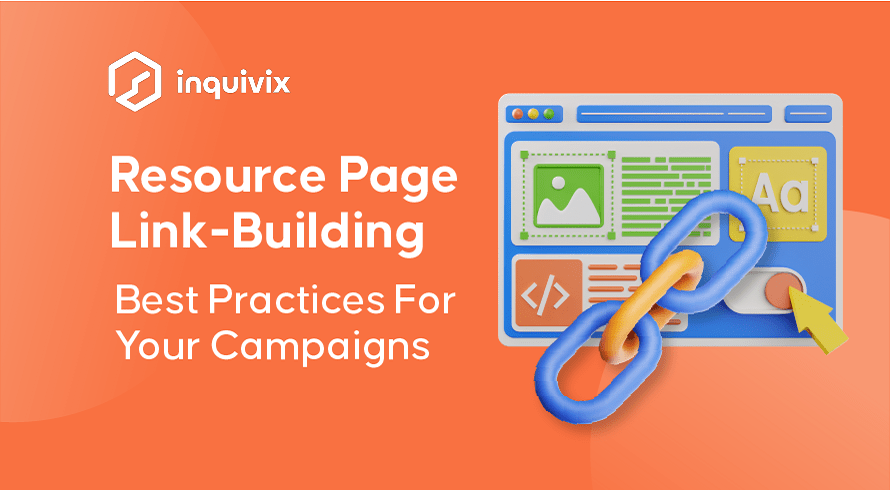
A successful link-building strategy is essential for getting your website more visibility online. One of the most effective ways to do this is through resource pages, which are web pages that contain a wealth of helpful information and resources on a particular topic. In this blog post, we’ll discuss some of the best practices site owners can use for building links with resource pages.
What Is Resource Page Link-Building?

Resource page link-building is an effective way to increase the visibility of a website and its associated content. It involves forming relationships and reaching out to webmasters who have created resource pages related to your industry, which often contain links that have been collected or otherwise shared to improve their usefulness as resources. The objective of this process is to ensure that the target web pages include a link back to your website in order for their visitors to benefit from your content. Creating these boosted pathways allows interested parties easy access to view your page and further engage with it and the information you offer.
Resource page link-building is a great strategy for inbound marketers looking to grow their authority through quality backlinks. This type of link-building involves finding and securing links from web pages that have created lists – or ‘resources’ – that are industry-specific. The focus of this kind of link-building is not only on the quality of the website but on how relevant its resources are to others in your industry. In other words, if the content found on a resource page is highly related to your business and its sector, gaining a backlink from these pages can help you gain visibility and authority within your target audience.
When you secure a backlink from another reputable website, it serves as an endorsement of sorts for your own website. A backlink from an authoritative source shows search engines that your content is trustworthy, which can positively impact how often you appear in search results. Additionally, when readers click through from a resource page, they are more likely to become engaged with your website since they already have an interest in the topic you discussed. Below are a few tips on how to build links from resource pages before we dive into the best practices to enhance the results of link-building efforts.
How To Build Links From Resource Pages
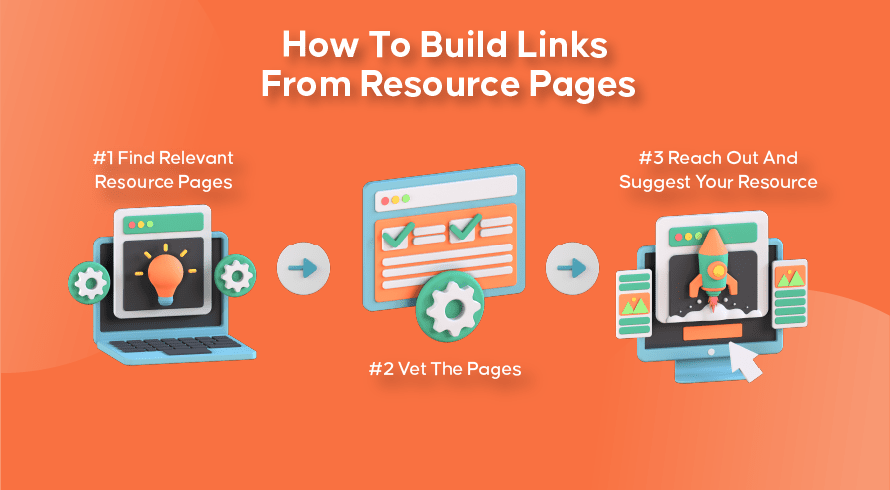
Building links is an essential part of SEO, but it can be hard to know where to start. One of the best strategies for getting quality links is to find relevant resource pages and suggest your own website as a resource. Here are three steps for building links from resource pages.
#1 Find Relevant Resource Pages
The first step in building links from resource pages is to identify relevant resource pages that are already out there. Use search engines to look for websites or blogs in your niche that contain resources related to your industry or topic. Make sure that you only target sites with a high domain authority; this will ensure that your link will have maximum impact.
#2 Vet The Pages
Once you’ve identified a few potential resource pages, take some time to vet them. Make sure they don’t contain any broken links, irrelevant content, or anything else that could reflect badly on your brand if you include a link on their page. Also, make sure they are actively maintained—you don’t want your link appearing on a dead-end page!
#3 Reach Out And Suggest Your Resource
Once you’ve identified and vetted the resource page, reach out and suggest your website as a valuable addition to the list. Offer up an explanation of why someone should visit your website and why it would be useful for readers of the blog or site in question—this will help increase the chances that the site owner will accept your request!
Best Practices For Resource Page Link-Building
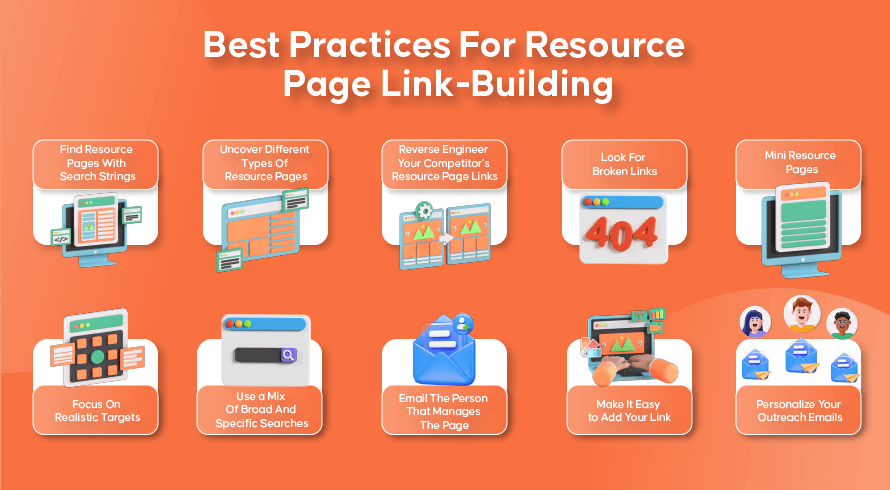
Here are 10 of the best methods you can use to ensure that link-building efforts using a resource page are successful.
Find Resource Pages With Search Strings
The first step in resource page link-building is finding relevant resource pages. The easiest way to do this is by using search strings on Google or another search engine. For example, if you’re looking for a resource page related to marketing, you might use the following Google search query: “inurl: resources/marketing”. This will return a list of web pages that contain “resources/marketing” in the URL. From there, you can analyze each result and determine if it’s a good fit for your needs.
Uncover Different Types Of Resource Pages
Once you have a list of potential resource pages, it’s important to understand the different types of resource pages out there. For example, some pages are dedicated solely to sharing resources related to their topic while others may feature curated lists of resources from around the web. Understanding these differences can help you decide which type of resource page will be most beneficial for your goals.
Reverse Engineer Your Competitor’s Resource Page Links
Once you have identified relevant resource pages and understand what types of content they typically feature, it’s time to reverse engineer your competitor’s resource page links. By finding out which sites are linking back to them, you can better understand who their audience is and how they’re promoting their content online. This information can be invaluable when crafting your own strategy for getting featured on these same types of resource pages and can be a wonderful link-building tactic for website owners to focus on.
Look For Broken Links
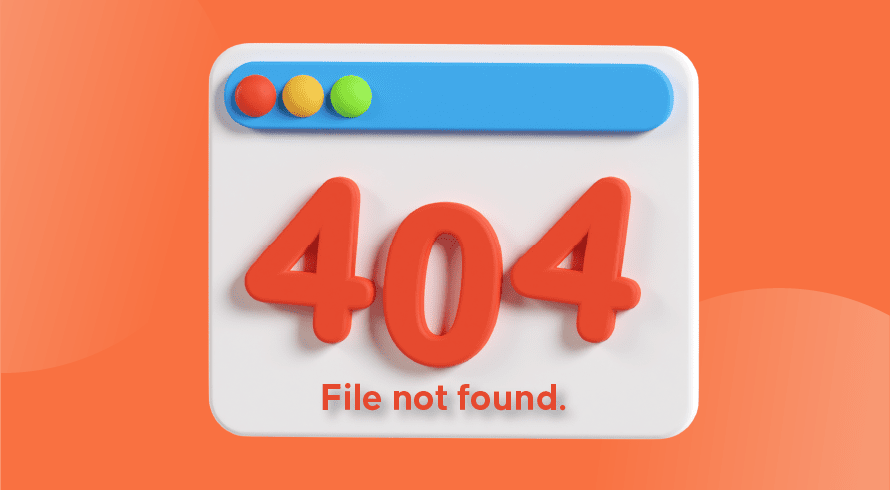
One of the most important steps in link-building is to look for broken links. Broken links are links that lead to pages that no longer exist or have moved elsewhere. This can be incredibly frustrating for users, so it’s important to find and fix any broken links on your website.
If you find any broken links on other websites, you can contact the website owner and offer your own website as a replacement for their broken link. This is an effective way to get more visibility and build valuable high-quality backlinks at the same time.
Mini Resource Pages
Another great way to build links with resource pages is by creating mini-resource pages. Mini-resource pages are condensed versions of resource pages that focus on one specific topic or category. They provide readers with targeted information about a certain subject without overwhelming them with too much content all at once. When done well, these types of dedicated resource pages that focus on one aim can be a great way to target specific audiences and draw attention to your website in new ways.
Focus On Realistic Targets
When it comes to link-building, it’s important not to set unrealistic targets for yourself or your team. It’s better to focus on achievable goals that will help you build quality and helpful links over time rather than aiming too high right away and becoming discouraged when you don’t reach your targets quickly enough. Take things slow and steady, and keep track of what works so you can continue improving upon your efforts as time goes on. This is a great method to ensure that you make the most of efficient link-building SEO strategies.
Use A Mix Of Broad And Specific Searches

Finding the right resource pages for link-building can be tricky. You want to make sure you search both broadly and specifically. This means you should use some generic search terms such as “resource page” or “link directory,” but also try more specific terms like “[keyword] resource page” or “[industry] link directory.” This will ensure you find the resource pages related to your industry. You can learn more about keyword matching on the link Google article.
Email The Person That Manages The Page
Once you have identified a potential resource page, it is important to reach out to the person who manages the page. You want to make sure they are open to adding new links and that they understand why your link would be beneficial to their visitors.
When creating an email template to reach out, make sure it is personal and explain why your website would be valuable for its visitors.
Make It Easy To Add Your Link
When submitting a request for a link on a resource page, make sure that you provide all of the necessary information in one place. This will help speed up their process of reviewing your request and adding your link if approved.
Make sure that you include a title, description, anchor text, URL, and any other pertinent information about your website in an easy-to-read format so they can quickly review it and add it if needed.
Personalize Your Outreach Emails
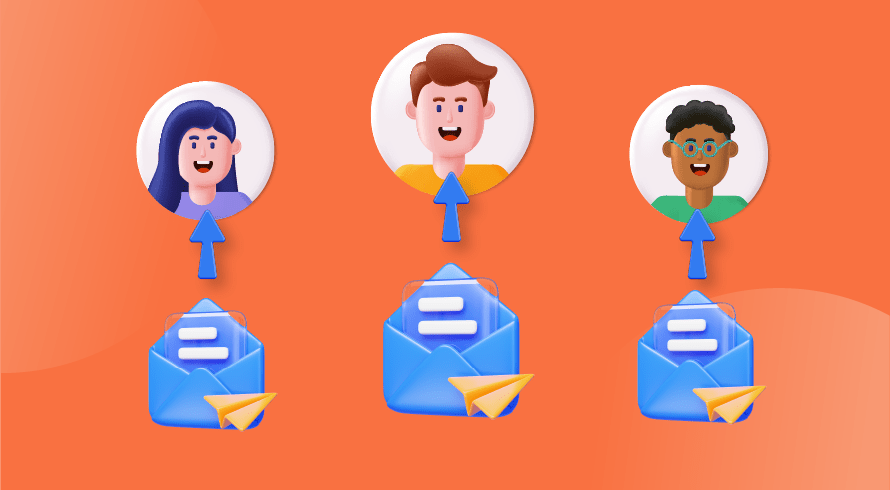
When trying to get your links added to other websites, personalizing each email is essential. Don’t just send out a generic template that says the same thing each time – take the time to write something unique that speaks directly to the person you’re trying to reach out to. Be sure to explain why their website would be a great fit for yours and why it would be beneficial for both of you if you were featured on their page. This type of personalized manual outreach will help them see the value in adding your link and increase the chances of them actually doing it!
Maximize The Results Of Your Resource Page Link-Building
Now that you know what resource page link-building is, how to build links from resource pages, and the best practices for resource page link-building, it’s time to put this information into action. Use these tips to increase your website’s authority and traffic flow. As always, if you need help along the way, our team of link-building experts is here to assist you. Give us a call or shoot us an email today!
FAQs
Resource Linking is a process that allows users to access and share online resources, such as web pages and documents, without needing to be online at the same time. With this capability, organizations can reduce maintenance costs and provide employees with more convenient ways to access information. It also has the potential to increase collaboration and teamwork among workgroups by increasing communication. Resource Linking can be used securely to mitigate risks associated with shared data or by providing a way for organizations to track user activity of shared resources. When coupled with sharing capabilities of cloud-based servers, it provides users with increased access control and improved efficiency. All in all, resource-linking technology has the potential to greatly improve overall productivity for any organization implementing it.
Creating an online resource guide to help others learn or discover something new can be an enlightening experience. You should start by researching relevant topics related to the guide’s purpose and purposeful keywords that are likely to make your guide easier for other people to locate online. Once you have some potential topics and keywords, decide on a layout for the resource guide that provides clarity and draws in readers. Emphasize keywords in any titles, headings, and transitions when creating content within the resource guide. Linking outside helpful resources with additional information can also increase its usefulness, while encoding video and graphic elements deepen user engagement with your resource guide. Invite feedback from people who already read the document or try advertising its availability through a variety of tactics—such as social media posts or banners on specific websites—to bring it to even more readers.
